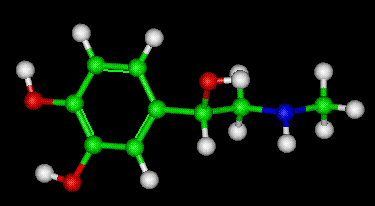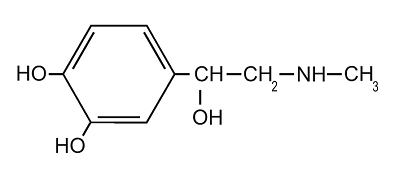Adrenaline/Epinephrine Molecule

Epinephrine Ball and Stick Model
To View the Epinephrine Molecule in 3D --->>in 3D with Jsmol
Epinephrine (also adrenaline, epi in medical jargon) is a hormone and acts as a neurotransmitter. Both names mean the same: the Latin roots ad-+renes and the Greek roots epi-+nephros both literally mean "on/to the kidney" (referring to the adrenal gland, which secretes epinephrine).
Epinephrine plays a central role in the stress reaction--the physiological response to conditions that threaten the physical integrity of the body. It is secreted by the adrenal medulla. When released into the bloodstream, epinephrine acts to increase heart rate and blood pressure, dilate the pupils, elevate the blood sugar level (by increased hydrolysis of glycogen to glucose), and redistribute blood flow away from the skin and inner organs.

Epinephrine is used as a drug in order to stimulate cardiac action in cardiac arrest, as a vasoconstrictor in anaphylactic shock and sepsis, and as a bronchodilator in acute bronchial asthma. Allergy patients undergoing immunotherapy can get an epinephrine rinse before their allergan extract is administered. Adverse reactions include palpitations, tachycardia, anxiety, headache, tremor, hypertension, and acute pulmonary oedema.
A pheochromocytoma is a tumor of the adrenal gland (or, rarely, the ganglia of the sympathetic nervous system) which secretes excessive amounts of catecholamines, usually epinephrine.
Chemically, epinephrine is a catecholamine hormone, a sympathomimetic monoamine derived from the amino acids phenylalanine and tyrosine. The chemical formula of epinephrine is C9H13NO3. Its structure is shown right.
Epinephrine was first isolated and identified in 1897 by John Jacob Abel. Jokichi Takamine discovered the same hormone in 1901, without knowing about the previous discovery, and called it adrenaline. It was first artificially synthesized in 1904 by Friedrich Stolz.
Readings and References
- Epinephrine - Pub Med